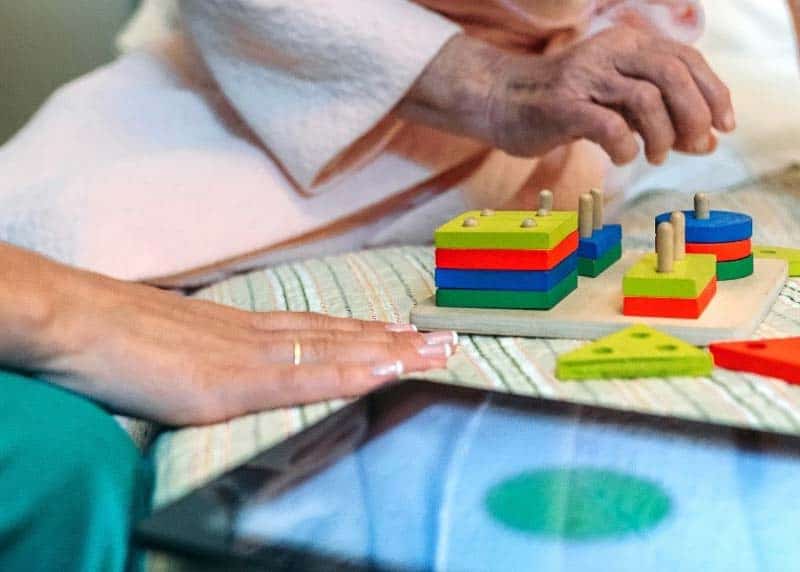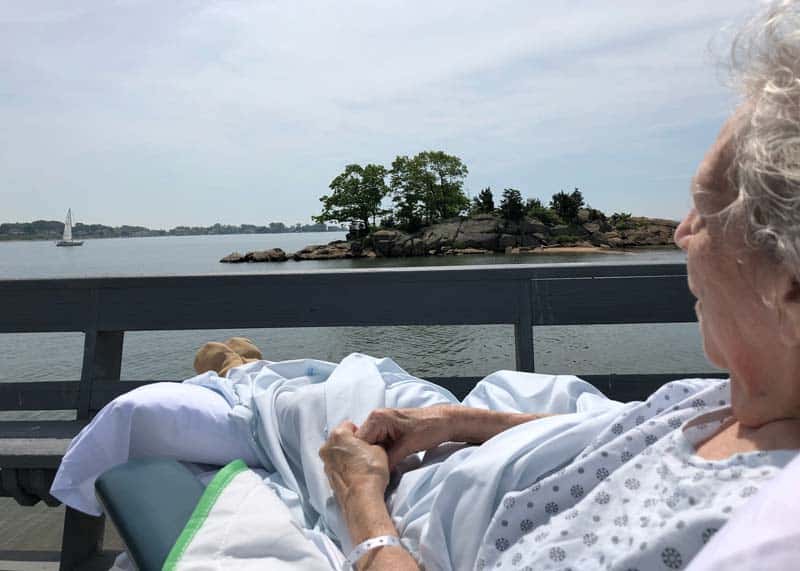Please view our updated COVID-19 guidelines and visiting procedures →.

In many parts of the country, people think of hospice care as home care, where nurses come into private homes and help caregivers take care of end of life patients. In our area, Connecticut Hospice’s large inpatient facility brings GIP (general inpatient) to families as well. But hospice care is not just provided in hospices, or in homes. It can be delivered in any setting where a patient lives.
When someone moves to a skilled nursing facility(SNF) or assisted living, that becomes the patient’s home, and home hospice can assist there. For nursing homes, especially, this can be a great boon for families. Especially during the pandemic, much has been written about staffing shortages at SNFs. Hospice nurses and aides can supplement the care given by a skilled nursing facility.
For example, eating can become an issue for people with certain conditions. Sometimes, carefully feeding by trained professionals can increase their caloric intake significantly. Very few places would have the ability to feed many patients that way, but home hospice care can bridge the gap. Often, aide service is requested during mealtimes, and supplements the resources available for meal assistance.

Personal care is another function of daily living that can become problematic, especially with dementia. Patients can become resistant to bathing, or may need time-consuming help with dental maintenance. Again, home hospice aides may be used to add extra resources for those aspects of ongoing support.


At Connecticut Hospice, we have trained all of our home care staff in special techniques to improve the quality of life for patients with dementia. There are methods for feeding, bathing, and other activities that will improve the outcomes for those who can receive such personal attention.

If a patient is accepted as appropriate for home hospice care, he or she becomes eligible for Medicare Hospice Benefits (MHB). Those benefits are specified by Medicare, which pays for most of the hospice care delivered across the country. There are certain parameters for entry into that service, and someone must be referred by a physician. At that point, he or she would be evaluated by a hospice service, and, if appropriate, can then be admitted for MHB.
This can take place in any setting. A patient residing in a skilled nursing facility would be visited there by a hospice representative, and then enrolled in that setting.
Or, a patient can be released from an inpatient hospital or hospice setting, and sent home or to a SNF or Assisted Living Facility (ALF) with home hospice care. Evaluation can take place before the patient is discharged, so that all necessary equipment and medications can be delivered before the patient gets to the next setting.

Home hospice care covers the cost of those medications, as well as the equipment needed. Routine home care does not provide that level of assistance. Sometimes, patients and families resist the use of hospice care, just because of the word “hospice”. Before declining such help, people should understand that Medicare Hospice Benefits are a component of Medicare, and that the financial implications can be great, depending upon the level of care authorized for a recipient.
Accepting hospice home care does not put a time limit on someone’s life, but it does mean that the normal trajectory of an illness would indicate an expected lifespan of less than six months, in the opinion of a referring physician. It also means that they are no longer seeking curative treatment for an illness. We call this “comfort care”, as opposed to active methods of fighting the disease. There is a great range of outcomes with this type of care, but many people live longer. If you need help deciding about when’s the right time for hospice care, we have a list of ready signals that you can discuss with your physician.
Since curative treatment can be debilitating, hospital stays generally take a toll on the patient. Careful management of symptoms, especially pain, is a hallmark of hospice care, and one that can lead to a better quality of life. That in and of itself can prolong a person’s “good” time, and improve his or her outlook. It does not, therefore, necessarily indicate defeat, or failure, to choose hospice care. There are many good reasons to consider comfort care in a safe and supportive setting.

Understanding the finances behind Medicare Hospice Benefits is also key to peace of mind. In a nursing home setting, the family either pays for room and board, or is covered by insurance or Medicaid, depending upon the level of assets a patient has. The extra care provided by a hospice is paid for by Medicare, directly to the hospice.
Even in assisted living, where usually an upfront cost has been paid by a patient, in order to cover whatever services are necessary, hospice care is covered by Medicare, if the person is referred and deemed appropriate. The rules about visitation and distribution of medications can be different, but the concept is the same. Again, the hospice is paid directly by the Center for Medicare Services, as it would be in a private home.
It’s worth a word at this point about virtual hospice in a hospital. If a family member is too ill to transfer to home or even an inpatient hospice setting, end of life services can be provided in a traditional hospice environment. In those cases, the referring hospital would call in a hospice, and it would admit the patient and provide services in the hospital bed.
The hospice pays room and board in those cases to the hospital, but the patient and his or her family is not involved in that process, nor is the family responsible for paying for the extra services of hospice personnel. Not all hospitals have such an arrangement with individual hospices, but it is worth asking to see whether that is an option in any particular case.

For those patients on private insurance, they are also generally available, and the hospice can check for authorization. Also important to remember is that those services can be additive, so that they supplement whatever care is being given already, and provide additional comfort and aid to caregivers.
One of the goals of comfort care is to ensure that patients receive adequate pain relief and symptom support. This alone can lengthen and/or improve life. Another consideration is the reduction of hospital time—if hospice care prevents additional hospitalizations, or reduces the length of stay, it’s understandable why Medicare would pay for it. Caregivers are taught to call hospice before dialing 911, because sometimes episodes can be managed without a trip to the emergency room.
There are resources available to assist patients and families along the journey of an illness, and they are both easily accessible and affordable. As the country’s first hospice, we know well the need for our services, and hope to help others access them whenever appropriate.
Learn more about hospice care, and its many settings.

As a not-for-profit, we depend on generous donors to help us provide customized services and therapies that aren’t completely covered by Medicaid, Medicare, or private insurance.
Please make a gift to help us sustain the highest standard of care.
Admissions may be scheduled seven days a week.
Call our Centralized Intake Department: (203) 315-7540.